By Leen Randell
Updated: Jul 09, 2024
10 Best Herbal Decoctions For Cystitis
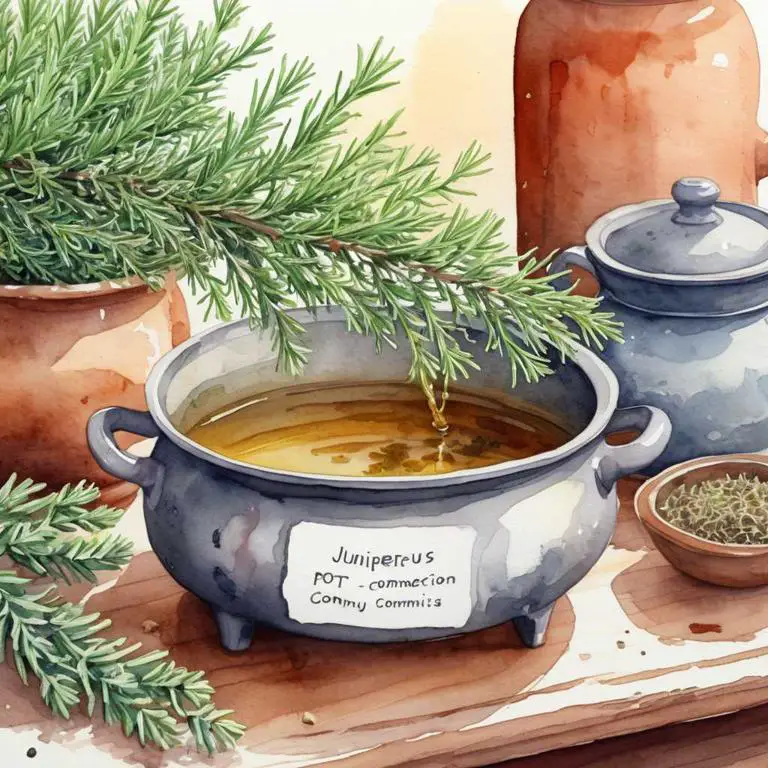
Herbal decoctions for cystitis are a natural remedy used to alleviate the symptoms of urinary tract infections (UTIs) such as pain, urgency, and frequency.
These decoctions help by providing anti-inflammatory, antimicrobial, and antioxidant properties that soothe the bladder and urethra, reducing inflammation and bacteria growth.
Examples of herbs used in decoctions for cystitis include goldenrod, marshmallow root, and corn silk, which have been shown to provide relief from UTI symptoms, allowing individuals to resume daily activities without discomfort or interruption.
The following article describes in detail the most important decoctions for cystitis, including medicinal properties, parts of herbs to use, and recipes for preparations.
- 1. Arctostaphylos uva ursi
- 2. Althaea officinalis
- 3. Solidago virgaurea
- 4. Zea mays
- 5. Achillea millefolium
- 6. Urtica dioica
- 7. Petroselinum crispum
- 8. Taraxacum officinale
- 9. Sambucus nigra
- 10. Zingiber officinale
- What is the best combination of herbal decoctions to use for cystitis?
- What ailments similar to cystitis are treated with herbal decoctions?
1. Arctostaphylos uva ursi
Bearberry decoctions helps with cystitis because of its anti-inflammatory and antimicrobial properties.
The uva ursi plant, also known as bearberry, contains compounds that reduce inflammation in the urinary tract, providing relief from burning sensations and urgency while urinating. Additionally, bearberry's antimicrobial effects help combat bacterial infections that can cause cystitis, promoting a healthy balance of gut flora and preventing future occurrences of the condition.
This natural remedy has been traditionally used to soothe and heal bladder issues, offering a safe and effective alternative to pharmaceutical treatments.
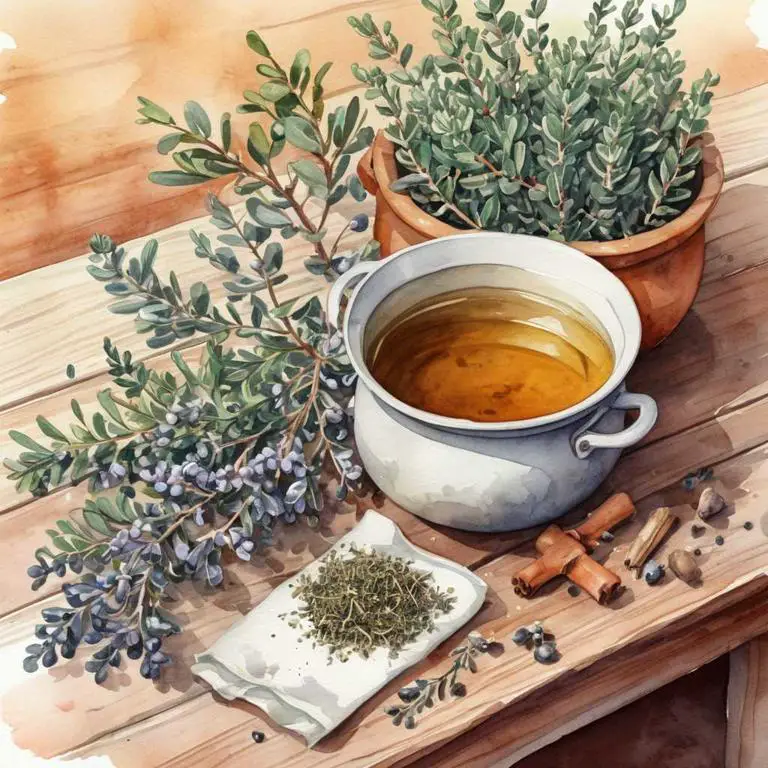
Medicinal Constituents
The list below shows the primary medicinal constituents in Arctostaphylos uva ursi decoctions that help with cystitis.
- Ursolic acid: A triterpenoid compound with anti-inflammatory properties, which helps reduce inflammation and discomfort associated with cystitis.
- Gallic acid: A phenolic compound with antimicrobial properties, which helps combat bacterial infections that can contribute to cystitis.
- Arbutin: A glycoside compound with astringent and anti-inflammatory properties, which helps reduce bladder irritation and inflammation, providing relief from cystitis symptoms.
Parts Used
The list below shows the primary parts of bearberry used to make decoctions for cystitis.
- Leaves: The astringent properties of Arctostaphylos uva ursi leaves help reduce inflammation and relieve symptoms of cystitis.
- Barks: The tannins present in the barks of Arctostaphylos uva ursi help to reduce inflammation and combat bacterial infections associated with cystitis.
- Fruits: The antioxidant and anti-inflammatory properties of Arctostaphylos uva ursi fruits aid in soothing and healing the urinary tract, thereby reducing cystitis symptoms.
Quick Recipe
The following recipe gives a procedure to make a basic bearberry for cystitis.
- Harvest approximately 2 ounces of dried arctostaphylos uva ursi leaves and stems from a trusted source.
- Weigh out 1 teaspoon of the dried arctostaphylos uva ursi material for every 8 ounces of water.
- Combine the measured arctostaphylos uva ursi material in a saucepan with the water and bring to a boil.
- Reduce the heat to a simmer for 10 to 15 minutes to allow the decoction to infuse.
- Strain the decoction through a cheesecloth or a fine-mesh sieve into a heat-resistant container to discard the solids.
2. Althaea officinalis
Marshmallow decoctions helps with cystitis because they provide soothing relief to inflamed bladder tissues.
The mucilages present in marshmallow roots, such as galactomannans, create a protective barrier that shields the bladder from irritants and reduces inflammation. Additionally, the decoction's anti-inflammatory properties help to alleviate pain and discomfort associated with cystitis.
As the decoction is absorbed into the body, it coats and calms the mucous membranes, reducing urinary frequency and urgency, ultimately providing natural relief from cystitis symptoms.
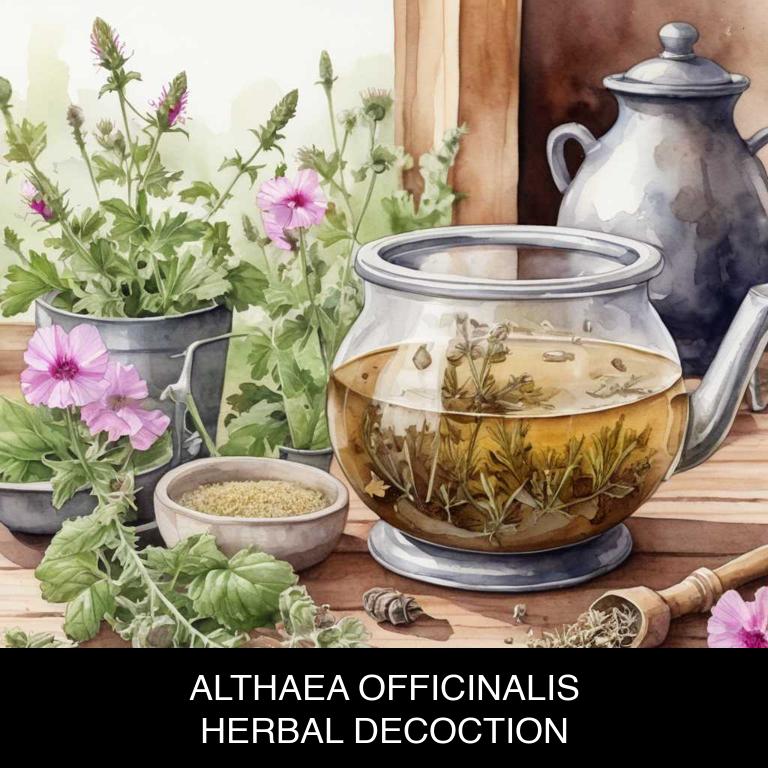
Medicinal Constituents
The list below shows the primary medicinal constituents in Althaea officinalis decoctions that help with cystitis.
- Mucilages: Mucilages help to soothe and protect the lining of the urinary tract, reducing inflammation and discomfort associated with cystitis.
- Phenolic acids: Phenolic acids exhibit antimicrobial properties, helping to combat bacterial infections that can cause cystitis, while also reducing inflammation and oxidative stress.
- Flavonoids: Flavonoids have anti-inflammatory and antioxidant properties, which help to reduce inflammation and oxidative stress in the urinary tract, alleviating symptoms of cystitis.
Parts Used
The list below shows the primary parts of marshmallow used to make decoctions for cystitis.
- Roots: The roots are the primary part used due to their high mucilage content, which helps soothe and protect the urinary tract.
- Leaves: The leaves are used for their anti-inflammatory properties, which aid in reducing inflammation and discomfort associated with cystitis.
- Barks: The barks are employed for their soothing and protective effects, helping to calm irritated tissues in the urinary tract.
Quick Recipe
The following recipe gives a procedure to make a basic marshmallow for cystitis.
- Measure out 2 grams of dried root and 500 ml of water for the decoction base.
- Combine the measured root and water in a saucepan and bring to a boil.
- Reduce heat to a simmer and let the decoction steep for 10 to 15 minutes.
- Strain the decoction through a cheesecloth or fine-mesh sieve into a clean container.
- Allow the decoction to cool to room temperature before storing it in the refrigerator.
3. Solidago virgaurea
Goldenrod decoctions helps with cystitis because its anti-inflammatory properties soothe the urinary tract, reducing discomfort and pain.
The decoction's antimicrobial action also combats bacterial infections that can exacerbate symptoms. Additionally, goldenrod's diuretic properties help to flush out bacteria and toxins from the bladder, promoting healthy urination and alleviating frequent or urgent urination.
As a result, goldenrod decoctions offer natural relief from the symptoms of cystitis, providing effective support for overall urinary health.
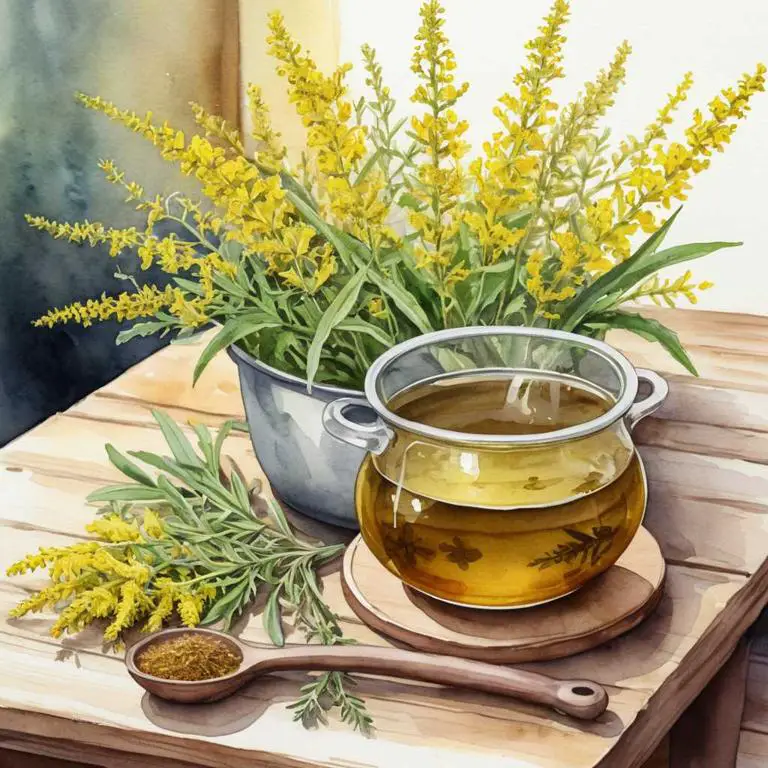
Medicinal Constituents
The list below shows the primary medicinal constituents in Solidago virgaurea decoctions that help with cystitis.
- Flavonoids: These compounds help with cystitis by reducing inflammation and oxidative stress in the urinary tract, which can alleviate symptoms and promote healing.
- Triterpenoids: Triterpenoids, such as ursolic acid, have anti-inflammatory and antimicrobial properties that can help combat infections and soothe the mucous membranes in the urinary tract.
- Polyphenolic acids: Polyphenolic acids, including caffeic acid and ferulic acid, possess antioxidant and anti-inflammatory properties that can help protect the bladder lining from damage, reduce pain, and prevent further irritation.
Parts Used
The list below shows the primary parts of goldenrod used to make decoctions for cystitis.
- Roots: They are used because they contain a high concentration of bioactive compounds that help to reduce inflammation and alleviate symptoms of cystitis.
- Leaves: They are used because they possess antimicrobial and anti-inflammatory properties that help to combat bacterial infections and soothe the urinary tract.
- Stems: They are used because they contain flavonoids and other compounds that help to reduce inflammation and promote healing in the urinary tract.
Quick Recipe
The following recipe gives a procedure to make a basic goldenrod for cystitis.
- Harvest 20-30 solidago virgaurea stems with flower heads at the peak of bloom in late summer.
- Dry the collected stems in a warm well-ventilated area for 2-3 weeks to reduce moisture content.
- Chop 1-2 teaspoons of dried solidago virgaurea into smaller pieces to increase surface area for infusion.
- Steep 1 teaspoon of chopped dried solidago virgaurea in 1 cup of boiling water for 5-7 minutes.
- Strain the herbal decoction through a cheesecloth or a fine-mesh sieve into a clean container.
4. Zea mays
Corn decoctions helps with cystitis because they possess anti-inflammatory and antimicrobial properties that can help alleviate symptoms such as burning pain, frequent urination, and blood in urine.
The antioxidants present in corn decoctions also work to reduce inflammation and repair damaged bladder tissue.
Additionally, the soothing properties of corn decoctions can calm irritated tissues, providing relief from discomfort and promoting a sense of well-being.
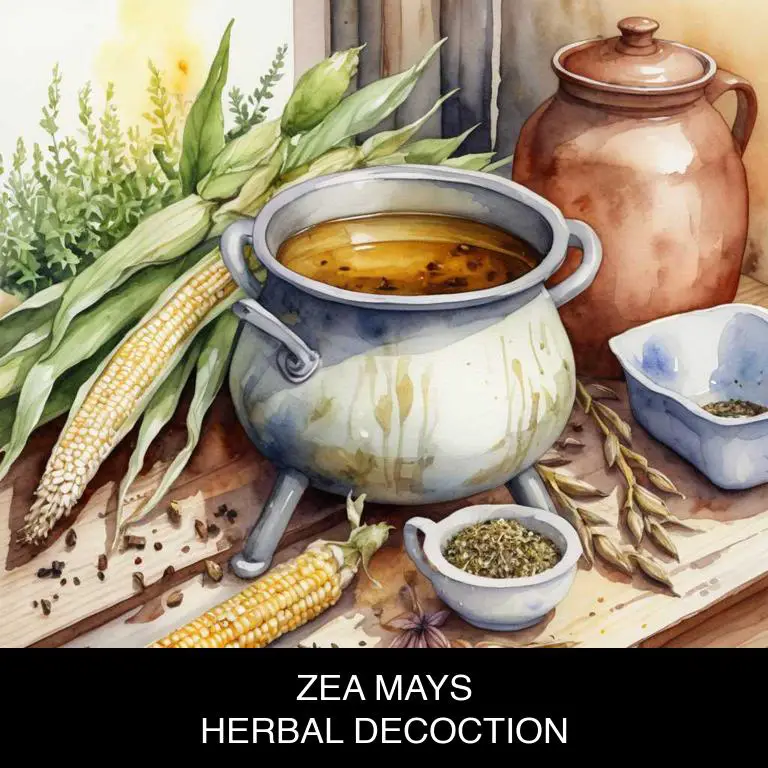
Medicinal Constituents
The list below shows the primary medicinal constituents in Zea mays decoctions that help with cystitis.
- Silica: Helps with cystitis by reducing inflammation and promoting the healing of damaged tissues, which can alleviate the discomfort associated with urinary tract infections.
- Saponins: Contributes to cystitis relief by having antimicrobial properties that can help combat bacterial infections, thereby reducing the severity of symptoms.
- Phenolic compounds: May help alleviate cystitis symptoms by exhibiting anti-inflammatory and antioxidant properties, which can minimize tissue damage and promote overall urinary system health.
Parts Used
The list below shows the primary parts of corn used to make decoctions for cystitis.
- Leaves: Used to make decoctions for cystitis due to their diuretic properties, which help to increase urine production and alleviate symptoms.
- Seeds: Used to make decoctions for cystitis due to their anti-inflammatory properties, which help to reduce inflammation and discomfort associated with the condition.
- Roots: Used to make decoctions for cystitis due to their antiseptic and antimicrobial properties, which help to prevent infections and promote healing.
Quick Recipe
The following recipe gives a procedure to make a basic corn for cystitis.
- Harvest mature zea mays ears and dry them thoroughly in a warm dark place for 2 weeks.
- Grind 2-3 teaspoons of dried zea mays into a fine powder using a mortar and pestle.
- Combine the zea mays powder with 1 quart of boiling water and let it steep for 10 minutes.
- Strain the zea mays decoction through a cheesecloth or a fine-mesh sieve into a clean bowl.
- Store the herbal zea mays decoction in the refrigerator for up to 3 days and consume as needed.
5. Achillea millefolium
Yarrow decoctions helps with cystitis because it contains flavonoids, which have anti-inflammatory properties that reduce swelling and discomfort in the bladder.
The decoction's antibacterial compounds also help combat E. coli and other bacterial infections that can cause cystitis. Additionally, yarrow's antispasmodic agents ease painful urination and reduce frequency and urgency of trips to the bathroom.
By soothing and calming the bladder and urinary tract, yarrow decoctions provide natural relief from the discomfort and pain associated with cystitis.
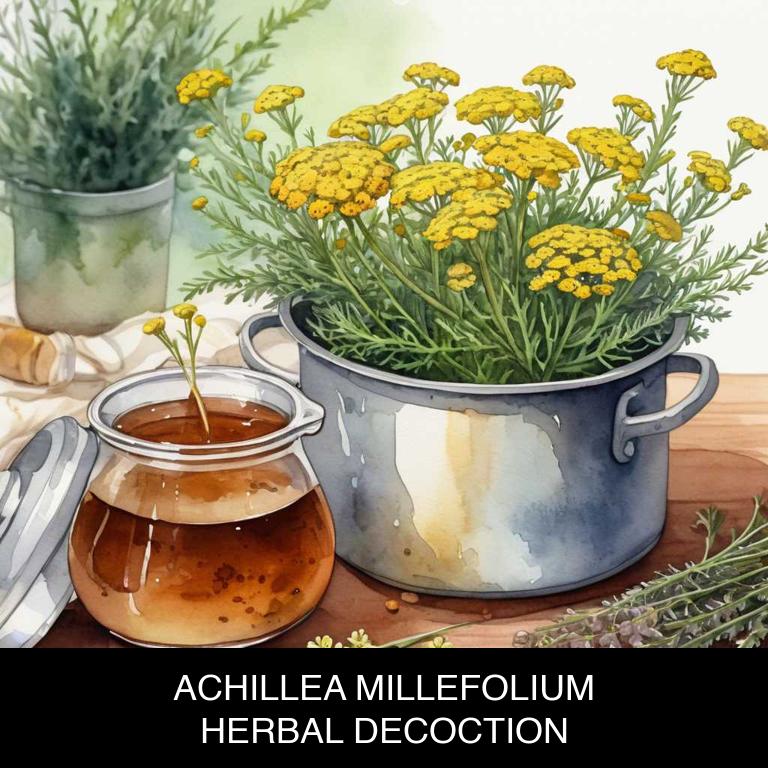
Medicinal Constituents
The list below shows the primary medicinal constituents in Achillea millefolium decoctions that help with cystitis.
- Phenolic acids: Phenolic acids, particularly chlorogenic acid, have anti-inflammatory and antimicrobial properties that help alleviate the symptoms of cystitis by reducing inflammation and combating bacterial infections.
- Flavonoids: Flavonoids possess anti-inflammatory, antioxidant, and immunomodulatory properties, which help to alleviate cystitis symptoms by reducing oxidative stress, inflammation, and pain.
- Caffeic acid derivatives: Caffeic acid derivatives exhibit anti-inflammatory and antimicrobial properties, which help to prevent bacterial adhesion to the bladder wall, reduce inflammation, and alleviate cystitis symptoms.
Parts Used
The list below shows the primary parts of yarrow used to make decoctions for cystitis.
- Leaves: They are used due to their high content of flavonoids and phenolic acids, which possess anti-inflammatory and antimicrobial properties beneficial for cystitis treatment.
- Flowers: They are used because of their high concentration of sesquiterpene lactones and flavonoids, which exhibit anti-inflammatory and antioxidant properties to alleviate cystitis symptoms.
- Roots: They are used due to their rich content of sesquiterpene lactones and polyacetylenes, which have anti-inflammatory and antimicrobial properties to help soothe cystitis.
Quick Recipe
The following recipe gives a procedure to make a basic yarrow for cystitis.
- Harvest 1-2 bunches of fresh achillea millefolium leaves and flowers in the morning for optimal potency retention.
- Chop the harvested plant material into small pieces to release its medicinal properties and facilitate infusion.
- Combine 1 teaspoon of chopped plant material with 1 cup of boiling water in a heat-resistant container.
- Steep the mixture for 5-10 minutes to allow the plant's active compounds to infuse into the water.
- Strain the decoction through a cheesecloth or a fine-mesh sieve into a cup or a container for storage.
6. Urtica dioica
Stinging nettle decoctions helps with cystitis because of its anti-inflammatory and diuretic properties.
The decoction's ability to reduce inflammation in the urinary tract helps alleviate symptoms such as burning during urination, frequent urination, and abdominal pain. Additionally, nettle's natural diuretic properties increase urine production, helping to flush out bacteria and other toxins that may be contributing to the infection.
By reducing inflammation and promoting healthy urine flow, stinging nettle decoctions provide a holistic approach to managing cystitis symptoms and promoting overall urinary health.
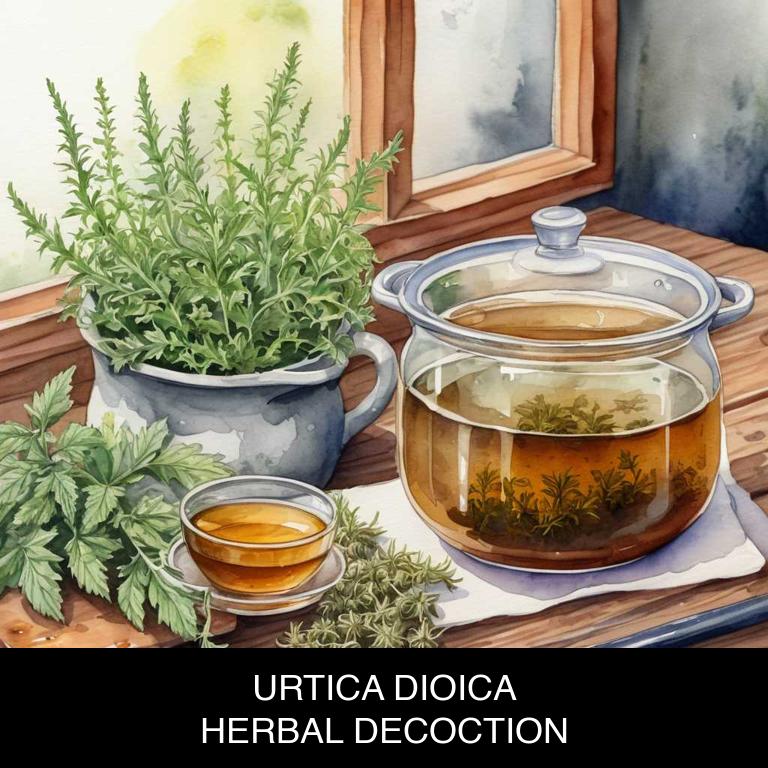
Medicinal Constituents
The list below shows the primary medicinal constituents in Urtica dioica decoctions that help with cystitis.
- Alkaloids: This constituent may help alleviate cystitis symptoms by acting as a natural antihistamine and reducing histamine-induced inflammation in the urinary tract.
- Tannins: Tannins in Urtica dioica may help soothe and protect the mucous membranes in the urinary tract, reducing inflammation and discomfort associated with cystitis.
- Phenolic acids: This constituent has been shown to exhibit anti-inflammatory and antimicrobial properties, which may help combat bacterial infections and alleviate symptoms associated with cystitis.
Parts Used
The list below shows the primary parts of stinging nettle used to make decoctions for cystitis.
- Leaves: They are rich in antioxidants and have anti-inflammatory properties, making them effective in soothing the urinary tract and reducing inflammation associated with cystitis.
- Roots: The roots contain compounds with anti-inflammatory and antimicrobial properties, helping to combat bacterial infections and alleviate symptoms of cystitis.
- Stems: The stems, rich in flavonoids and other compounds, have been traditionally used to treat urinary tract issues, including cystitis, due to their anti-inflammatory and diuretic properties.
Quick Recipe
The following recipe gives a procedure to make a basic stinging nettle for cystitis.
- Gather 2-4 parts of fresh urtica dioica leaves and stems from a clean source.
- Rinse the gathered urtica dioica plant material under cold running water for 30 seconds.
- Combine the rinsed plant material with 1 part of boiling water in a heat-resistant container.
- Steep the mixture for 5-7 minutes at a temperature of 95-100 degrees celsius.
- Strain the mixture through a fine-mesh sieve into a separate container discarding the solids.
7. Petroselinum crispum
Parsley decoctions helps with cystitis because it has anti-inflammatory and antibacterial properties that help reduce swelling and infection in the urinary tract.
The flavonoids present in parsley also have a soothing effect on the bladder lining, reducing inflammation and discomfort caused by cystitis.
Additionally, parsley's natural diuretic properties help increase urine production, flushing out bacteria and toxins from the body, which helps alleviate symptoms of cystitis such as burning sensation while urinating and frequent urges to pee.
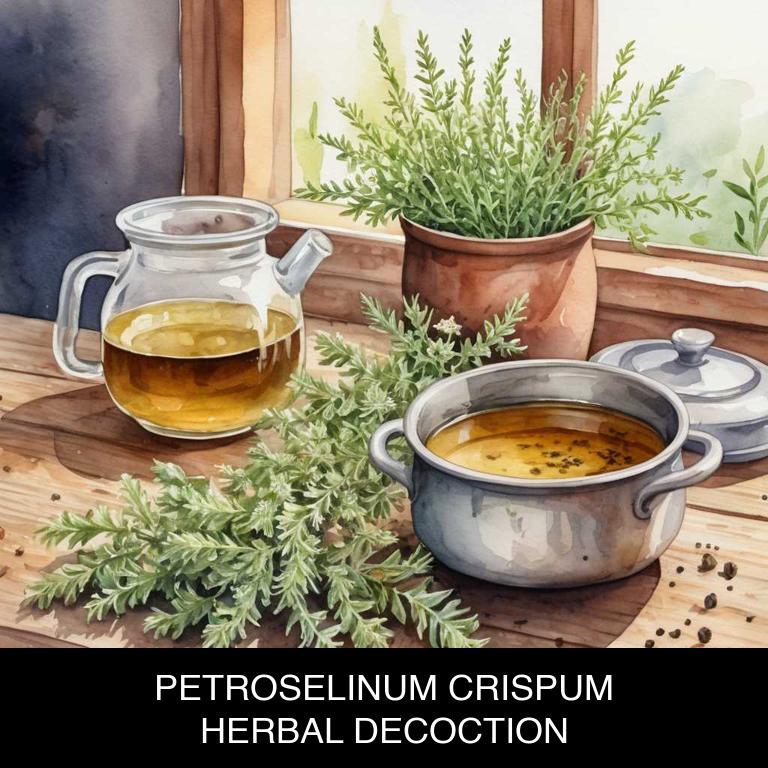
Medicinal Constituents
The list below shows the primary medicinal constituents in Petroselinum crispum decoctions that help with cystitis.
- Apigenin: A flavonoid that may help reduce inflammation and alleviate symptoms associated with urinary tract infections (UTIs), such as cystitis, by inhibiting bacterial growth and modulating the immune response.
- Apiol: A terpene that may possess antimicrobial properties, helping to combat the bacterial infections that cause cystitis, and also exhibit anti-inflammatory effects to reduce discomfort and pain.
- Falcarinol: A polyene that may help soothe and protect the urinary tract, reducing inflammation and promoting healing of damaged tissues, which could contribute to the relief of cystitis symptoms.
Parts Used
The list below shows the primary parts of parsley used to make decoctions for cystitis.
- Leaves: Used due to their diuretic properties, which help increase urine production and alleviate symptoms of cystitis.
- Stems: Utilized for their anti-inflammatory effects, which can help soothe and calm the urinary tract.
- Roots: Employed for their antiseptic and antimicrobial properties, which can help prevent infections and promote healing in the urinary tract.
Quick Recipe
The following recipe gives a procedure to make a basic parsley for cystitis.
- Gather 2 tablespoons of dried petroselinum crispum leaves and 1 liter of boiling water for decoction.
- Steep the dried petroselinum crispum leaves in boiling water for 5-7 minutes to release active compounds.
- Strain the liquid mixture through a fine-mesh sieve into a clean container to remove solids.
- Discard the solids and store the decoction in an airtight container in the refrigerator for up to 3 days.
- Heat the refrigerated decoction over low heat for 2-3 minutes to restore its potency before consumption.
8. Taraxacum officinale
Dandelion decoctions helps with cystitis because of its potent anti-inflammatory and diuretic properties.
The plant's leaves, roots, and flowers contain bioactive compounds that help to reduce inflammation in the urinary tract, alleviating symptoms such as burning pain while urinating and frequent urination. Additionally, dandelion's diuretic effects increase urine production, which helps to flush out bacteria and other irritants that can contribute to cystitis.
This natural remedy has been used for centuries to provide relief from cystitis and its associated discomfort.

Medicinal Constituents
The list below shows the primary medicinal constituents in Taraxacum officinale decoctions that help with cystitis.
- Taraxasterol: This triterpene has anti-inflammatory properties that help reduce inflammation and irritation in the urinary tract, providing relief from cystitis symptoms.
- Taraxasterol acetate: Similar to taraxasterol, this triterpene has anti-inflammatory and antimicrobial properties, which help combat bacterial infections and alleviate pain associated with cystitis.
- Kaempferol: A flavonoid with antioxidant properties, kaempferol helps reduce oxidative stress and inflammation in the urinary tract, promoting healing and recovery from cystitis.
Parts Used
The list below shows the primary parts of dandelion used to make decoctions for cystitis.
- Leaves: Used due to their high concentration of taraxasterol, a triterpene that has anti-inflammatory properties beneficial for cystitis treatment.
- Roots: Utilized for their diuretic properties, which help in flushing out the urinary tract and relieving cystitis symptoms.
- Flowers: Employed due to their ability to reduce inflammation and alleviate pain associated with cystitis.
Quick Recipe
The following recipe gives a procedure to make a basic dandelion for cystitis.
- Harvest 20-30 leaves and roots of the plant in the morning after dew has dried.
- Cut the harvested plant parts into small pieces using scissors or a sharp knife.
- Combine the cut plant parts with 2 cups of water in a saucepan and bring to boil.
- Reduce heat to simmer for 10-15 minutes or until the liquid has reduced by half.
- Strain the decoction through a cheesecloth or a fine-mesh sieve into a clean container.
9. Sambucus nigra
Elder decoctions helps with cystitis because of its natural anti-inflammatory and antibacterial properties.
The decoction's flavonoids and phenolic acids work together to reduce inflammation in the urinary tract, alleviating the burning sensation associated with cystitis.
Additionally, the antimicrobial compounds present in elderberry help combat bacterial infections that can cause recurring episodes of cystitis, promoting a healthy balance of gut bacteria and reducing symptoms such as pain, frequency, and urgency.
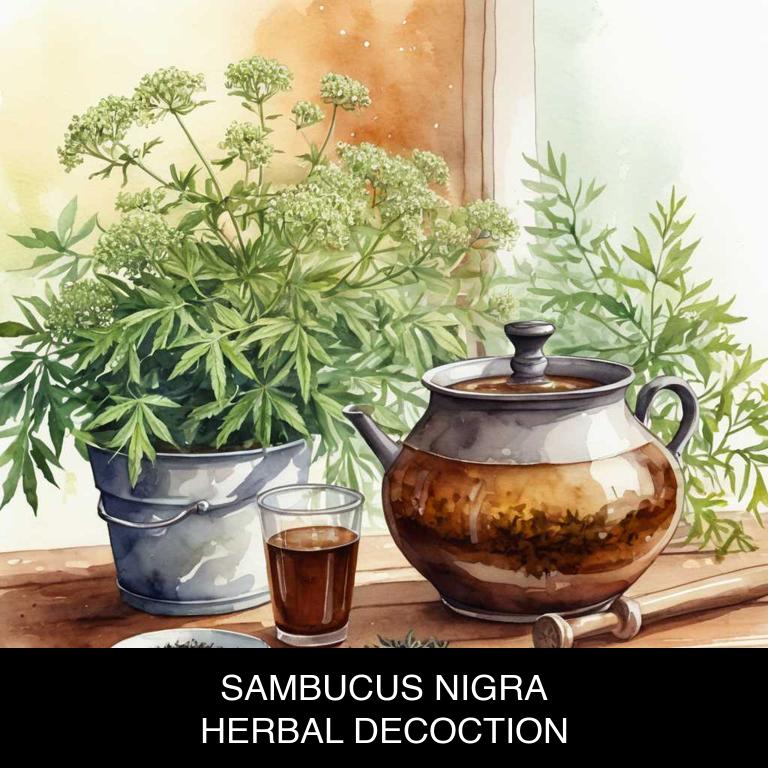
Medicinal Constituents
The list below shows the primary medicinal constituents in Sambucus nigra decoctions that help with cystitis.
- Flavonoids: These plant compounds have anti-inflammatory and antimicrobial properties, which help reduce inflammation and prevent bacterial infections that contribute to cystitis.
- Phenolic acids: These compounds exhibit antioxidant and antimicrobial activities, helping to protect the urinary tract from damage and infections that cause cystitis.
- Ellagic acid: This polyphenol has anti-inflammatory and antimicrobial properties, which can help reduce inflammation and prevent bacterial infections in the urinary tract, alleviating cystitis symptoms.
Parts Used
The list below shows the primary parts of elder used to make decoctions for cystitis.
- Flowers: They are rich in anthocyanins, flavonoids, and phenolic acids, which have anti-inflammatory and antioxidant properties that help alleviate cystitis symptoms.
- Leaves: They contain flavonoids and phenolic acids, which exhibit anti-inflammatory and antimicrobial activities, contributing to the treatment of cystitis.
- Stems: They are rich in flavonoids and other bioactive compounds that help reduce inflammation and combat bacterial infections associated with cystitis.
Quick Recipe
The following recipe gives a procedure to make a basic elder for cystitis.
- Harvest the sambucus nigra flowers, berries and leaves in the morning after the dew has evaporated.
- Dry the harvested sambucus nigra flowers, berries and leaves in a warm well-ventilated area for 7 to 10 days.
- Measure out 5 to 10 grams of dried sambucus nigra flowers, berries and leaves for every 250 milliliters of water used.
- Combine the measured dried sambucus nigra flowers, berries and leaves with 250 milliliters of boiling water in a saucepan and steep for 10 to 15 minutes.
- Strain the decoction through a cheesecloth or a fine-mesh sieve into a cup or a glass bottle to remove the solids.
10. Zingiber officinale
Ginger decoctions helps with cystitis because they possess potent anti-inflammatory and antibacterial properties that help alleviate symptoms such as burning sensations while urinating, frequent urination, and pelvic pressure.
The decoction's active compounds, like gingerols and shogaols, have been shown to inhibit the growth of E. coli and other bacteria responsible for causing the infection, reducing inflammation and discomfort in the urinary tract.
Additionally, ginger's natural antispasmodic properties help relax the muscles in the bladder and urethra, providing relief from pain and discomfort associated with cystitis.
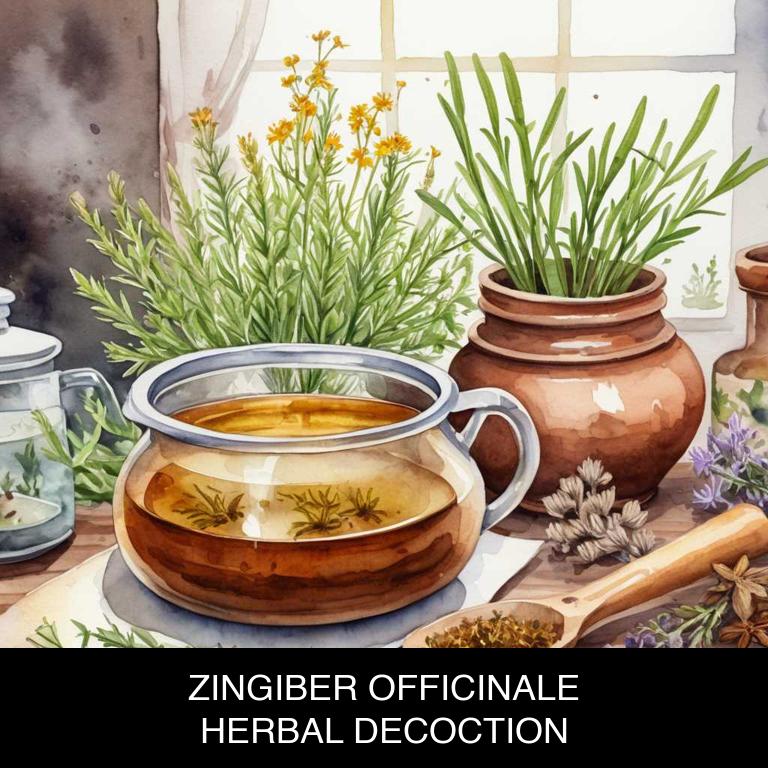
Medicinal Constituents
The list below shows the primary medicinal constituents in Zingiber officinale decoctions that help with cystitis.
- 6-gingerol: It has anti-inflammatory and antispasmodic properties, which can help alleviate the pain and discomfort associated with cystitis by reducing inflammation and relaxing the bladder muscles.
- Gingerol: It has antimicrobial properties, which can help combat bacterial infections that may be contributing to cystitis, such as E. coli and other urinary tract pathogens.
- Shogaol: It has anti-inflammatory and antioxidant properties, which can help reduce inflammation and oxidative stress in the urinary tract, alleviating symptoms of cystitis such as pain, burning sensations, and frequent urination.
Parts Used
The list below shows the primary parts of ginger used to make decoctions for cystitis.
- Rhyzomes: The most commonly used part, rhyzomes are utilized due to their high concentration of active compounds like gingerols and shogaols, which have anti-inflammatory and antispasmodic properties.
- Roots: The roots of Zingiber officinale contain similar active compounds as rhyzomes and are often used as an alternative when rhyzomes are not available.
- Barks: The barks of the Zingiber officinale plant are also used in decoctions for cystitis, particularly in traditional medicine, as they contain compounds that help to reduce inflammation and alleviate symptoms.
Quick Recipe
The following recipe gives a procedure to make a basic ginger for cystitis.
- Chop 5-10 grams of fresh zingiber officinale rhizomes into small pieces for easy decoction.
- Combine the chopped rhizomes with 500ml of water in a saucepan.
- Bring the mixture to a boil over medium heat for 5-7 minutes.
- Reduce the heat to low and simmer for an additional 10-15 minutes.
- Strain the decoction through a cheesecloth or fine-mesh sieve into a clean container.
What is the best combination of herbal decoctions to use for cystitis?
The best combination of herbal decoctions that help with cystitis is a blend of Uva Ursi, Juniper berries, and Marshmallow root.
Uva Ursi contains arbutin, which helps reduce inflammation and antibacterial properties. Juniper berries aid in flushing out the urinary tract and reducing spasms, while Marshmallow root soothes and protects the bladder and urethra.
This combination helps to alleviate symptoms of cystitis, such as pain and burning during urination, and promotes a healthy balance of the urinary tract.
What ailments similar to cystitis are treated with herbal decoctions?
Ailments similar to cystitis/decoctions.html">cystitis/decoctions.html">cystitis that are treated with herbal decoctions are urinary tract infections, kidney stones, and prostatitis.
Herbs like Urva Ursi, Horsetail, and Goldenrod have anti-inflammatory and antibacterial properties that help alleviate symptoms such as burning sensation while urinating, frequency, and urgency.
Decoctions made from these herbs can also help reduce inflammation and promote healing in the urinary tract.